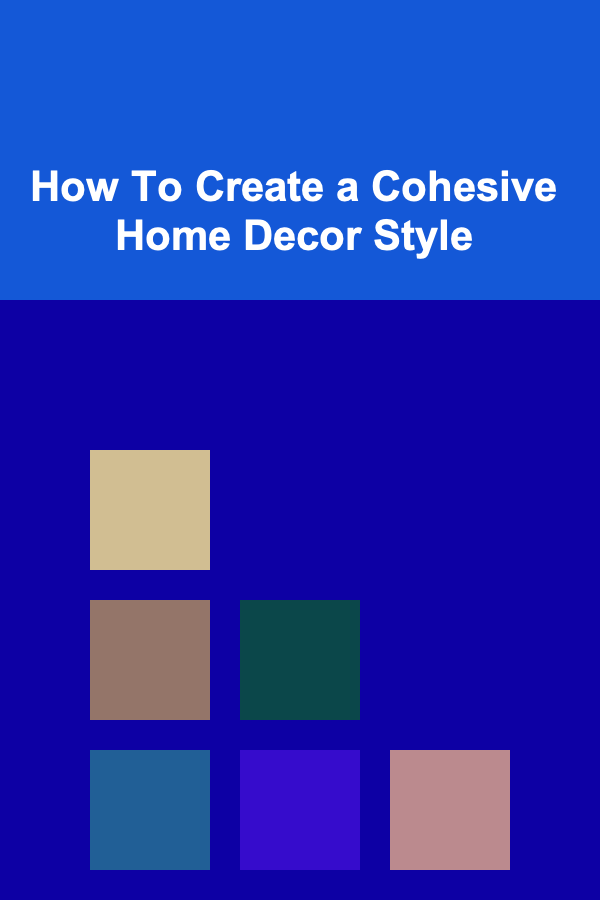
How To Create a Cohesive Home Decor Style
ebook include PDF & Audio bundle (Micro Guide)
$12.99$7.99
Limited Time Offer! Order within the next:

Creating a cohesive home decor style is more than just picking out pretty things. It's about crafting a harmonious environment that reflects your personality, lifestyle, and aesthetic preferences. A cohesive home feels intentional, welcoming, and comfortable. It's a space where everything works together, from the color palette to the furniture arrangement, to create a unified and pleasing whole. This article delves into the process of developing a cohesive home decor style, offering practical advice and inspiring ideas to help you transform your house into a haven.
I. Understanding Cohesion in Interior Design
Cohesion in interior design refers to the harmonious blending of elements within a space to create a unified and balanced visual experience. It's about ensuring that all aspects of the decor -- color, texture, pattern, furniture style, lighting, and accessories -- work together to tell a consistent story. A cohesive design doesn't necessarily mean matching everything perfectly; it's about creating a sense of unity and flow throughout the home.
Why is cohesion important?
- Creates a Sense of Calm and Harmony: A cohesive design minimizes visual clutter and creates a more relaxing and enjoyable atmosphere.
- Enhances Aesthetic Appeal: A well-designed space is simply more visually appealing. Cohesion elevates the overall aesthetic and makes the home feel more polished and refined.
- Reflects Personal Style: A cohesive design allows you to express your personal style in a thoughtful and intentional way. It shows that you've put thought and effort into creating a space that truly represents you.
- Increases Property Value: While not the primary goal, a well-designed and cohesive home can increase its perceived value and appeal to potential buyers.
II. Identifying Your Style: The Foundation of Cohesion
Before you start making any decorating decisions, it's crucial to identify your personal style. This is the foundation upon which you'll build your cohesive design. Take some time to explore different styles and determine what resonates most with you.
A. Explore Different Design Styles:
Familiarize yourself with a variety of popular design styles to see what appeals to you. Here are a few examples:
- Modern: Characterized by clean lines, minimalist aesthetics, neutral colors, and functional furniture. Emphasizes simplicity and uncluttered spaces.
- Mid-Century Modern: A retro style inspired by the 1950s and 1960s. Features organic shapes, tapered legs, bold colors, and a focus on functionality.
- Bohemian (Boho): A relaxed and eclectic style that embraces natural materials, vibrant colors, patterns, and textures. Often incorporates vintage finds, global influences, and plants.
- Industrial: Inspired by warehouses and factories. Features exposed brick, metal accents, raw wood, and utilitarian furniture.
- Farmhouse: A cozy and inviting style that celebrates rustic charm, natural materials, and vintage elements. Often incorporates white, beige, and other neutral colors.
- Scandinavian: A minimalist and functional style that emphasizes natural light, light colors, and simple furniture. Promotes a sense of calm and well-being.
- Coastal: A light and airy style that evokes the feeling of being by the sea. Features light colors, natural textures, and nautical accents.
- Traditional: A classic and formal style that incorporates rich colors, ornate details, and elegant furniture. Emphasizes symmetry and balance.
- Contemporary: A constantly evolving style that reflects current trends. Often features a mix of modern and traditional elements.
B. Gathering Inspiration:
Collect visual inspiration from various sources:
- Pinterest: Create mood boards and save images of rooms, furniture, and decor that you love.
- Instagram: Follow interior designers, home decor bloggers, and brands to stay updated on the latest trends and gather ideas.
- Magazines: Browse interior design magazines for inspiration and to identify common themes and styles that appeal to you.
- Websites and Blogs: Explore interior design websites and blogs for articles, tutorials, and inspiration.
- Visit Show Homes and Furniture Stores: See different styles in person and get a feel for the furniture and accessories you like.
C. Identifying Common Threads:
Once you've gathered a collection of inspiration, look for common threads and patterns. Ask yourself the following questions:
- What colors do I gravitate towards?
- What types of furniture shapes and materials do I prefer?
- What textures and patterns appeal to me?
- What kind of feeling do I want my home to evoke? (e.g., cozy, sophisticated, modern, relaxed)
- What are the key elements that make me feel comfortable and happy in a space?
Answering these questions will help you pinpoint your personal style and identify the key elements that will contribute to a cohesive design.
III. Establishing a Color Palette: The Backbone of Cohesion
Color is a powerful tool in interior design. Establishing a cohesive color palette is crucial for creating a sense of unity and harmony throughout your home. A well-chosen color palette will tie all the elements of your decor together, from the walls to the accessories.
A. Choosing Your Colors:
Start by selecting a few key colors that will form the basis of your palette. Consider the following factors:
- Personal Preference: Choose colors that you love and that make you feel good.
- Existing Elements: Consider the existing colors in your home, such as flooring, cabinetry, and furniture that you don't plan on replacing.
- Mood and Atmosphere: Think about the mood you want to create in each room. Warm colors (red, orange, yellow) tend to be energizing and inviting, while cool colors (blue, green, purple) tend to be calming and relaxing.
- Natural Light: Consider the amount of natural light in each room. Darker rooms may benefit from lighter colors, while brighter rooms can handle bolder hues.
A good approach is to choose a dominant color, a secondary color, and an accent color. The dominant color will be used for the walls and large pieces of furniture. The secondary color will be used for smaller pieces of furniture, rugs, and window treatments. The accent color will be used for accessories and pops of color.
B. Utilizing Color Schemes:
Learn about different color schemes to help you create a balanced and harmonious palette:
- Monochromatic: Uses different shades and tints of a single color. Creates a sophisticated and calming effect.
- Analogous: Uses colors that are adjacent to each other on the color wheel (e.g., blue, blue-green, green). Creates a harmonious and relaxing feel.
- Complementary: Uses colors that are opposite each other on the color wheel (e.g., blue and orange). Creates a vibrant and energetic feel. Use this sparingly as it can be overwhelming.
- Triadic: Uses three colors that are equally spaced on the color wheel (e.g., red, yellow, blue). Creates a balanced and vibrant feel.
- Neutral: Uses a combination of neutral colors such as white, gray, beige, and brown. Creates a calm and sophisticated effect. Can be accented with pops of color.
C. Creating a Mood Board:
Create a physical or digital mood board to visualize your color palette. Include paint swatches, fabric samples, images of furniture, and accessories that reflect your chosen colors. This will help you see how the colors will work together in your space and make adjustments as needed.
IV. Choosing Furniture and Accessories: Building a Cohesive Collection
Once you've established your color palette, it's time to choose furniture and accessories that complement your style and contribute to the overall cohesion of your home.
A. Considering Style and Scale:
Choose furniture that aligns with your chosen design style and is appropriately sized for your space. Avoid overcrowding rooms with too much furniture. Consider the following:
- Style Consistency: Ensure that your furniture pieces share a similar aesthetic. For example, if you've chosen a modern style, avoid mixing in overly ornate or traditional pieces.
- Scale and Proportion: Choose furniture that is appropriately sized for the room. Large rooms can handle larger pieces, while smaller rooms require smaller, more streamlined furniture.
- Functionality: Choose furniture that is not only stylish but also functional and meets your needs.
B. Incorporating Texture and Pattern:
Texture and pattern can add depth and interest to your decor. Use a variety of textures and patterns to create a visually appealing and engaging space. Consider the following:
- Texture: Incorporate different textures, such as smooth, rough, soft, and hard, to create visual interest. Use fabrics, rugs, and accessories with varying textures to add depth to your design.
- Pattern: Use patterns sparingly and strategically. Choose patterns that complement your color palette and style. Consider using different scales of patterns to create visual interest.
- Balancing Act: Be mindful of balancing textures and patterns. If you have a lot of pattern in your room, keep the textures relatively simple. Conversely, if you have a lot of texture, you can afford to use more subtle patterns.
C. Accessorizing with Intention:
Accessories are the finishing touches that can truly bring your home decor together. Choose accessories that complement your style and add personality to your space. Consider the following:
- Personal Touch: Incorporate personal items that reflect your interests and hobbies.
- Art and Decor: Choose art and decor that complements your color palette and style.
- Greenery: Add plants to bring life and vibrancy to your space.
- Less is More: Avoid cluttering your space with too many accessories. Choose a few key pieces that make a statement and enhance the overall aesthetic.
V. Lighting: Setting the Mood and Enhancing Cohesion
Lighting plays a crucial role in creating the right atmosphere and enhancing the cohesion of your home decor. A well-lit space is not only functional but also visually appealing.
A. Layering Lighting:
Use a combination of different types of lighting to create a balanced and well-lit space. Consider the following:
- Ambient Lighting: Provides overall illumination for the room. Examples include ceiling fixtures, chandeliers, and recessed lighting.
- Task Lighting: Provides focused light for specific tasks. Examples include desk lamps, reading lamps, and under-cabinet lighting.
- Accent Lighting: Highlights specific features or objects in the room. Examples include spotlights, picture lights, and wall sconces.
B. Choosing the Right Fixtures:
Choose lighting fixtures that complement your style and enhance the overall aesthetic of your home. Consider the following:
- Style Consistency: Ensure that your lighting fixtures align with your chosen design style.
- Scale and Proportion: Choose lighting fixtures that are appropriately sized for the room.
- Light Temperature: Consider the light temperature of your bulbs. Warm light (2700K-3000K) creates a cozy and inviting atmosphere, while cool light (4000K-5000K) creates a brighter and more energizing atmosphere.
C. Creating Ambiance:
Use lighting to create the desired mood and atmosphere in each room. Consider the following:
- Dimmer Switches: Install dimmer switches to adjust the brightness of your lights and create a more intimate atmosphere.
- Warm Light in Bedrooms: Use warm light in bedrooms to create a relaxing and inviting space.
- Bright Light in Kitchens: Use bright light in kitchens to provide ample illumination for cooking and other tasks.
VI. Maintaining Cohesion: Consistency and Evolution
Creating a cohesive home decor style is an ongoing process. It's important to maintain consistency over time while also allowing for evolution and change.
A. Creating a Design Plan:
Develop a comprehensive design plan that outlines your chosen style, color palette, furniture selections, and accessories. This will serve as a guide to ensure that all future decorating decisions align with your overall vision.
B. Avoiding Impulse Purchases:
Resist the urge to make impulse purchases that don't fit with your design plan. Before buying anything new, ask yourself if it complements your existing decor and contributes to the overall cohesion of your home.
C. Embracing Evolution:
While it's important to maintain consistency, it's also important to allow for evolution and change. Your style may evolve over time, and that's perfectly normal. Feel free to update your decor as needed to reflect your changing tastes and preferences.
D. Editing and Decluttering:
Regularly edit and declutter your home to maintain a sense of order and visual clarity. Get rid of items that no longer serve a purpose or that don't fit with your overall aesthetic. A clutter-free space will feel more cohesive and inviting.
VII. Room-by-Room Considerations: Applying Cohesion Throughout Your Home
While the overall principles of cohesion apply to the entire home, each room has its unique characteristics and requirements. Consider these room-specific factors when creating a cohesive design.
A. Living Room:
The living room is often the focal point of the home and should reflect your personal style while also being comfortable and inviting. Focus on creating a balanced and harmonious space with comfortable seating, a focal point (such as a fireplace or artwork), and carefully chosen accessories. Consider the flow of traffic and arrange furniture to encourage conversation and interaction.
B. Bedroom:
The bedroom should be a relaxing and tranquil sanctuary. Choose calming colors, soft textures, and comfortable bedding to create a restful atmosphere. Minimize clutter and distractions. Consider the placement of your bed and ensure that it is the focal point of the room. Add personal touches, such as artwork and photos, to make the space feel more personal.
C. Kitchen:
The kitchen should be both functional and stylish. Choose durable and easy-to-clean materials. Consider the layout of your kitchen and ensure that it is efficient and well-organized. Incorporate storage solutions to minimize clutter. Add pops of color with accessories, such as dish towels and cookware. Lighting is crucial in the kitchen, so ensure that you have adequate ambient, task, and accent lighting.
D. Bathroom:
The bathroom should be a clean and refreshing space. Choose moisture-resistant materials and fixtures. Consider the layout of your bathroom and ensure that it is functional and efficient. Incorporate storage solutions to minimize clutter. Add pops of color with accessories, such as towels and bath mats. Lighting is important in the bathroom, so ensure that you have adequate ambient and task lighting.
E. Dining Room:
The dining room should be an elegant and inviting space for entertaining. Choose a dining table and chairs that are appropriately sized for the room. Consider the lighting and create a warm and inviting atmosphere with a chandelier or pendant lights. Add decorative elements, such as a centerpiece or artwork, to enhance the overall aesthetic. Consider the flow of traffic and ensure that guests can move around comfortably.
VIII. Common Mistakes to Avoid: Pitfalls of Incohesive Design
Even with the best intentions, it's easy to fall into common traps that can lead to an incohesive design. Being aware of these pitfalls can help you avoid them and create a more harmonious home.
- Overcrowding: Too much furniture or too many accessories can create a cluttered and overwhelming space.
- Mismatching Styles: Mixing too many different styles without a clear unifying element can create a disjointed and chaotic look.
- Ignoring Scale and Proportion: Choosing furniture that is too large or too small for the room can throw off the balance of the space.
- Neglecting Color Harmony: Using too many conflicting colors or ignoring the principles of color theory can create a visually jarring effect.
- Poor Lighting: Inadequate or poorly placed lighting can make a room feel dark and uninviting.
- Lack of Personalization: A home that lacks personal touches can feel sterile and impersonal.
- Impulse Buying: Buying items on impulse without considering how they will fit into your overall design plan can lead to a mismatched and incohesive look.
IX. Conclusion: Creating a Home that Tells Your Story
Creating a cohesive home decor style is a journey that requires patience, planning, and a willingness to experiment. By understanding the principles of cohesion, identifying your personal style, establishing a color palette, choosing furniture and accessories with intention, and layering lighting effectively, you can transform your house into a haven that reflects your personality and lifestyle. Remember to maintain consistency over time while also allowing for evolution and change. A cohesive home is not just a visually appealing space; it's a place where you feel comfortable, relaxed, and truly at home. Ultimately, the goal is to create a space that tells your story and reflects your unique personality.

How to Create a Pet-Friendly Bathroom Setup
Read More
How to Find the Right Financial Advisor for Your Investment Goals
Read More
How to Sell Digital Products Successfully for Non-Tech Savvy Individuals
Read More
How to Sell Your Rare Vinyl Records Through Virtual Music Fairs: An Actionable Guide
Read More
How to Stage Your Home for Pet Lovers
Read More
The Account Executive's Guide: Mastering Sales Strategies and Client Relationships
Read MoreOther Products

How to Create a Pet-Friendly Bathroom Setup
Read More
How to Find the Right Financial Advisor for Your Investment Goals
Read More
How to Sell Digital Products Successfully for Non-Tech Savvy Individuals
Read More
How to Sell Your Rare Vinyl Records Through Virtual Music Fairs: An Actionable Guide
Read More
How to Stage Your Home for Pet Lovers
Read More